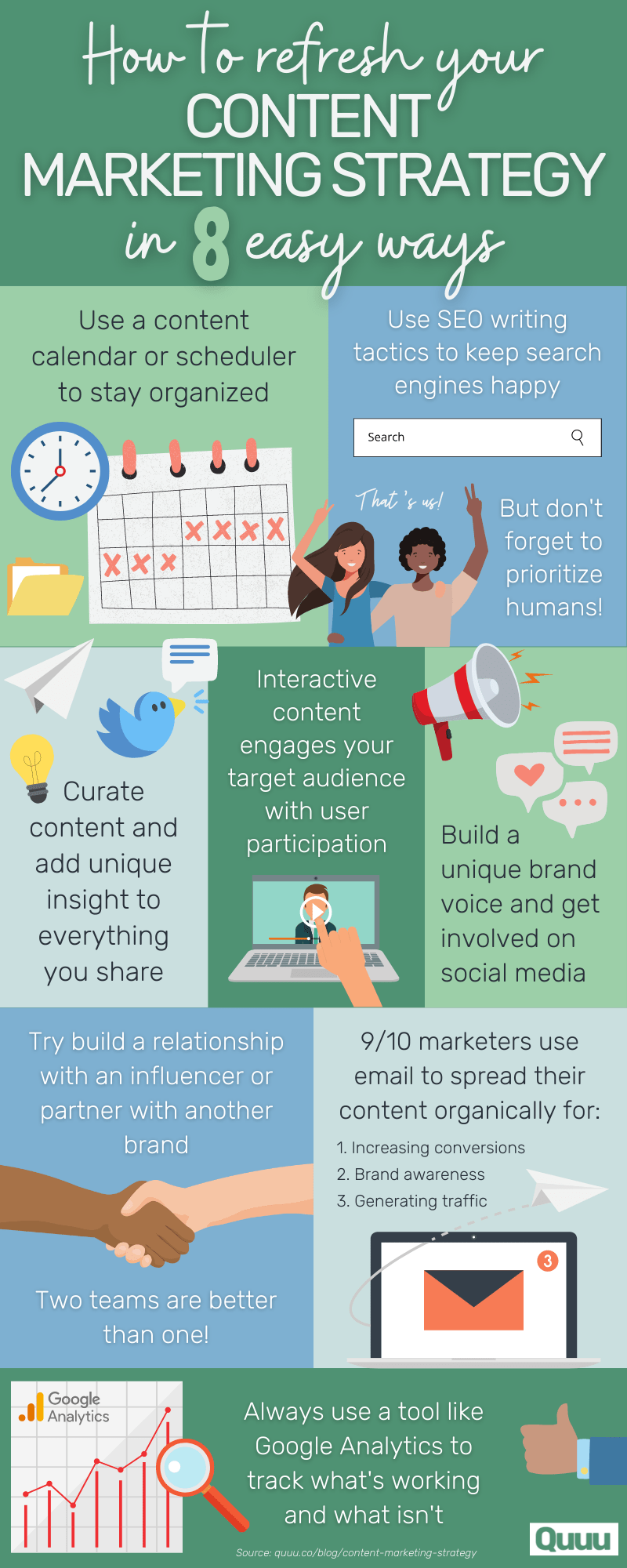Do you randomly post pieces of content and expect results? Do you think some influencer hyping your product will boost sales? Are you even tracking any metrics?
Is your mind scrambled after reading that? Mine too!
Your content marketing strategy needs work. Otherwise you wouldn’t be here. But it’s cool. Ours does too. There’s always room to improve.
It’s actually a lot simpler than it seems. So, don’t worry. Content marketing doesn’t have to be complicated. And a little tweak here and there can work wonders.
So, here are 8 ways to instantly refresh your content marketing strategy:
- Use a content calendar or scheduler
- SEO blog posts
- Curated content
- Interactive content
- Social media posts
- Influencer marketing and co-branded content
- Email marketing
- Track what’s working and what isn’t

1. Use a content calendar or scheduler
Every good strategy starts with a plan. But what you need will depend on your business goals.
If you’re a solopreneur who’s doing it all, you might just want some content scheduled in advance. If you’ve got a marketing team, a content calendar could keep everyone on the same page.
Social schedulers like Socialchief are simple, slick, and sexy. Your content marketing plan can be just that. Sometimes, all you want to see is what you’re going to be posting over the next couple of weeks.

Source: Socialchief
But if you need more detail, a content calendar could be for you. One that streamlines your content team’s workflow. That lets you see a load of different scheduled content on all the platforms you’re on.
Something like this template from Monday:

Source: Monday
Is this a better fit for you than a scheduler? If so, Content Marketing Institute shared 7 steps to a more strategic editorial calendar:
- Determine who needs to be included
- Identify goals for the quarter
- Decide the types of content you’ll post and when
- Specify details on the calendar
- Brainstorm topics for your content types
- Plan for flexibility
- Measure results to determine success
Whichever you pick, you need to do 2 things. Choose an overall goal for your content marketing strategy. Then plan content in advance that’ll get you there.
2. SEO blog posts
Most content marketing efforts start with articles and long-form blog posts. Because they’re the easiest to put together and post. There are no tricky formats to get your head round.
But over 90% of content gets no organic traffic from Google. Nada. Zilch. Which probably doesn’t fill you with much confidence for your content marketing strategy.

Source: Ahrefs
So, how do you get eyes on your new content?
Search engine optimization (SEO) helps your content rank on search engines. If you want to see your site on Google’s first page, you’ll need to use some SEO writing tactics.
These are things like:
- Keyword research
- Figuring out search intent
- Creating a captivating title
- Structuring with certain headings
- Link-building
- Meta descriptions
- Making it mobile-friendly
If you need details, check the link above for a step-by-step guide. Either way, remember this next thought.
Yes, keywords and all that technical stuff is important. But don’t forget who you’re really writing for.

Source: GIPHY
Humans.
SEO writing can help your content rank. But the humans reading it make it stay up there. Because of this, you need to make sure your content:
- Answers their questions
- Is easy to read and digest
- Uses conversational copy
- Has plenty of visuals
- Is interactive where possible
Great content has to hit both. Keep search engines happy. But your human readers happier.
3. Curated content
It’s super important. But digital marketing isn’t all about content creation. But a lot of people make that mistake.
Curated content should be a huge part of a successful content marketing strategy too. This is content you share that you didn’t create yourself. But why would you want to curate this kind of thing?
Well, there are so many benefits:
- Curating keeps your content calendar full
- You can become a thought leader by adding unique insight
- Content curation tools (like Quuu) can give you quality content to share
- It mixes up original content, so you don’t look too self-promotional
- Curated content increases social signals (linked to SEO)
- It’s a great opener to start networking with influencers
- It can increase engagement and build a community

Source: Quuu
Research tools for curation are awesome. But what if you want to do some manual digging? To find the kind of content no one has shared yet.
Here are a few places to find different types of content to curate:
- Good old Google
- RSS feeds
- Content roundups and threads on social media
- Email newsletters
- Infographics from blog posts
- Hashtags specific to your industry
- Podcasts on Spotify or Apple
- Videos and webinars on YouTube and TikTok
Retweeting is easy. And yes, it’s a form of curated content. But that’s where a lot of people stop. And that’s where they get it wrong.
But there’s one easy fix that’ll take your content curation to the next level. Adding unique insight.
Let your audience know why they should bother with what you’re sharing. Because there’s an endless stream of content to choose from. And time is limited. So, make sure yours stands out.
4. Interactive content (podcasts, videos, infographics, etc.)
The rise of digital marketing means we’ve got access to our favorite brands 24/7. Your customers are always able to interact with you in some way. So, how can you keep them coming back?
Well, your content marketing strategy should revolve around the experience you’re providing. You want to encourage people to engage with you. And what’s more engaging than interactive content?
Interactive content needs a bit of user participation. These are things like:
- Animated infographics
- 360° videos
- Polls and surveys
- Free tools (e.g. calculators and analyzers)
- Quizzes
Here’s a cool example of a 360° vid:
We know how popular visual content is. Humans are visual creatures. So, it’s not surprising.
Infographics do so well because of the visual element. Which is way more engaging than a wall of text. And 80% of online users will watch a video. But only 20% of them will read the content.
Taking video marketing to the next level
But what makes someone actually interact with a video? Rather than just leaning back in their chair absorbing it? Well, check this out.
Videos like these are going to be the future of marketing campaigns. Click on the screen while watching to switch between the “dream” and “reality” versions:

Source: Eko
It’s so creative. And so engaging. And soon, it’ll be the norm.
But what about podcasts? I know what you’re thinking. They’re just passively consumed too, right? Well, maybe they used to be. But not any more.
Spotify added Q&A and Poll features to some of their podcasts last year. People can now interact with the creators. So, it’s no longer a one-way street. And these kinds of tools are going to start popping up everywhere.

Source: Spotify
So, maybe you don’t have the time or budget for this kind of interactive content just yet. But in the meantime, these 12 clever content marketing examples could inspire something more achievable.
Time to get creative!
5. Social media posts
If you think everything you post on social media isn’t “content”, you’re wrong. This is the place to directly communicate with your target audience. So, everything you post is a form of content.
To nail this, you need to find out which demographics are on each platform. So, try creating buyer personas for potential customers. These are fictional representations of your target audience. But based on real data.
Then, you need to figure out your buyer’s journey. Why are they heading to your social channels? What could you have waiting for them there? Address their pain points.
70% of marketers on social media use it to increase brand awareness. By that logic, you should only be sharing your best content. Don’t post something just to fill your feed. That’s what curating’s for.

Source: Sprout Social
How you “speak” on social media is important too. Your brand voice is a huge part of an effective content marketing strategy. It’s what’ll identify you on all platforms.
Take Mexican fast food giant Chipotle. Their brand voice is super chill, fun, and relatable. They type how they know their audience talks:
Or there’s MoonPie who makes chocolatey marshmallow snacks. Their tweets make barely any sense most of the time. But people still love them. We mostly use social media to be entertained nowadays. And MoonPie get it:
The lesson here? Don’t be afraid to be silly on social media. People love humor. And light-hearted posts. GIFs and memes can be great for this.
But how do you create a unique brand voice of your own? Well, here’s how you start:
- Think up those buyer personas I mentioned before
- Complete some brand voice exercises (listed in the blog linked above!)
- Make a template for your voice
- Practice with all content you share
- Create guidelines to stay consistent
Keep your posts high-quality. Post regularly. And reply to your audience. Engaging with others is key if you want engagement on your own posts.
6. Influencer marketing and co-branded content
Some of the most engaged audiences on social media belong to influencers. And influencer marketing is one of the most talked-about marketing strategies.
An influencer sharing a startup’s content can seem like a golden ticket. But there’s a lot more to a successful campaign than that.
It starts with choosing the right influencer. High follower counts don’t mean high engagement. Nano and micro-influencers actually have the smallest but most active audiences.

Source: Later
So, how do you find the best fit for your business? Well, there are tools out there that can help you find influencers in your niche. For example, BuzzSumo scans millions of profiles to find ones with genuine authority.
Just remember: relevance is way more important than reach. And once you’ve found your match, that’s the hardest part over.
After that, keep these tips in mind:
- Don’t be afraid to give the influencer creative control
- Keep it genuine
- Track your campaign’s success
- Try to build long-term relationships
Two teams are better than one
Co-branded content is another partnership. But one between 2 brands. And just like influencers, you have to choose who you work with carefully.
But there are loads of obvious benefits once you do:
- Any costs are halved
- Content reach increases with a new audience
- Generates buzz
- Starts and develops industry relationships
- Builds trust with consumers
- Accesses another team’s creative ideas
Red Bull and GoPro sell very different products. But a very similar experience. They promote a lifestyle that’s action-packed and fearless:
Their space-jump collaboration didn’t promote either company directly. But it was an awesome brand awareness campaign for their shared values.
Something like that probably isn’t viable for most of us. But once you find a partner, you have tons of options. You could create co-branded shareable infographics. Or do some Instagram Story takeovers.
Go as big or small as you want. You’ll soon find what works and what doesn’t.
7. Email marketing
Building a loyal audience is the dream for every business owner. And the easiest way to do this is with the right content. And lots of it.
But what if your audience is scattered over tons of different platforms? Tracking your content’s effect is a lot harder. So, turning them all into email subscribers brings them to one place.
Email marketing is a series of planned content with a specific goal. And 9 out of every 10 marketers use email to distribute their content organically.

Source: Oberlo
A solid email list is the backbone of a successful content marketing strategy. So, what are these specific goals you can have?
Well, your email campaign might be for:
- Brand awareness – using educational content
- Focusing on conversions – sending lead nurturing content
- Generating traffic – promoting high-value content
- Existing customers – follow-up content
If you’re new to email marketing, there are tons of tools that make it easy. This will save you wasting a lot of time on something that might not even look that great!
Try some of these popular options:
You can create personalized templates for mass-sending. Or A/B test content to see what gets the highest open rates. Whatever you do, give email a shot to amplify your content marketing strategy.
8. Track what’s working and what isn’t
Every so often, you need to assess your content marketing tactics. Which blog posts have high website traffic but low conversions? Which social media channels are your target audience engaging on most? Where is your traffic coming from?
Goal-setting is important. And tracking your progress is essential.

Source: Positive Psychology
KPIs (key performance indicators) are important if you want to reach your marketing goals. But you need to get specific. So, break them down into different areas.
Here are some examples:
| Brand awareness | Lead generation | Higher conversion rate |
| Increase social shares | Add CTAs to landing pages | Which content converts |
| Higher article views | Decrease cost-per-click (if promoting content) | Reduce length of sales cycle |
| More audience engagement | Increase number of subscribers | Increase time on page |
For most metrics, Google Analytics is the go-to tool. It’s in-depth and invaluable. Which is awesome because it’s also free.
Here, you can see which content is doing well. And what’s not so much.

You can use GA to track things like:
- Pages with a high bounce rate
- What people are searching for on your site
- Which content has high engagement
- What drives conversions
- When is the best time to publish
Content audits can also be really helpful. A gap analysis evaluates your own content to spot anything you’ve missed. You want to make sure your anything you create:
- Supports your customer journey
- Solves needs better than competitor keywords
- Is crafted with search intent in mind
Read case studies. Research white papers. Become a data-driven marketer. Your strategy will thank you for it.
Conclusion
There are so many ways you can mess up your content marketing strategy. Most without even realizing. But a bit of analysis can make a huge difference.
For example, maybe you’ve been missing:
- A planned schedule
- SEO writing tactics
- Curated content
- Interactive content
- Consistent social media posts
- Partnership marketing
- Building and using an email list
- Tracking results
Each of these are all pieces of a whole. And you’ll be surprised what each can do for brand awareness. Just focus on one area at a time. And see what effect it has. You could find your new growth hack for the year.
Have you had success with any of these content marketing strategy tips? Are there any you think we’ve missed? Let us know below!





